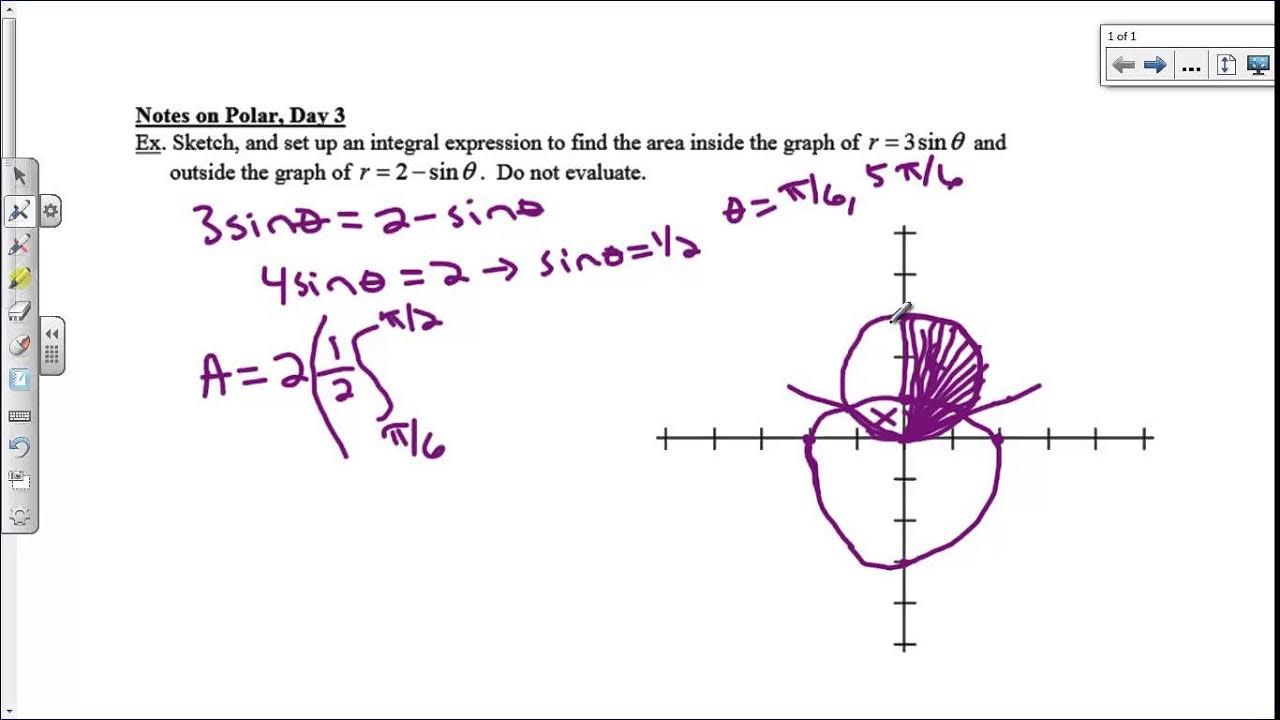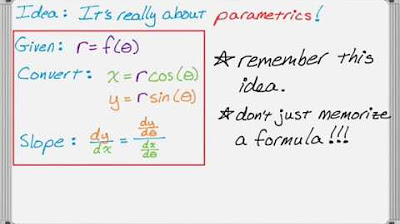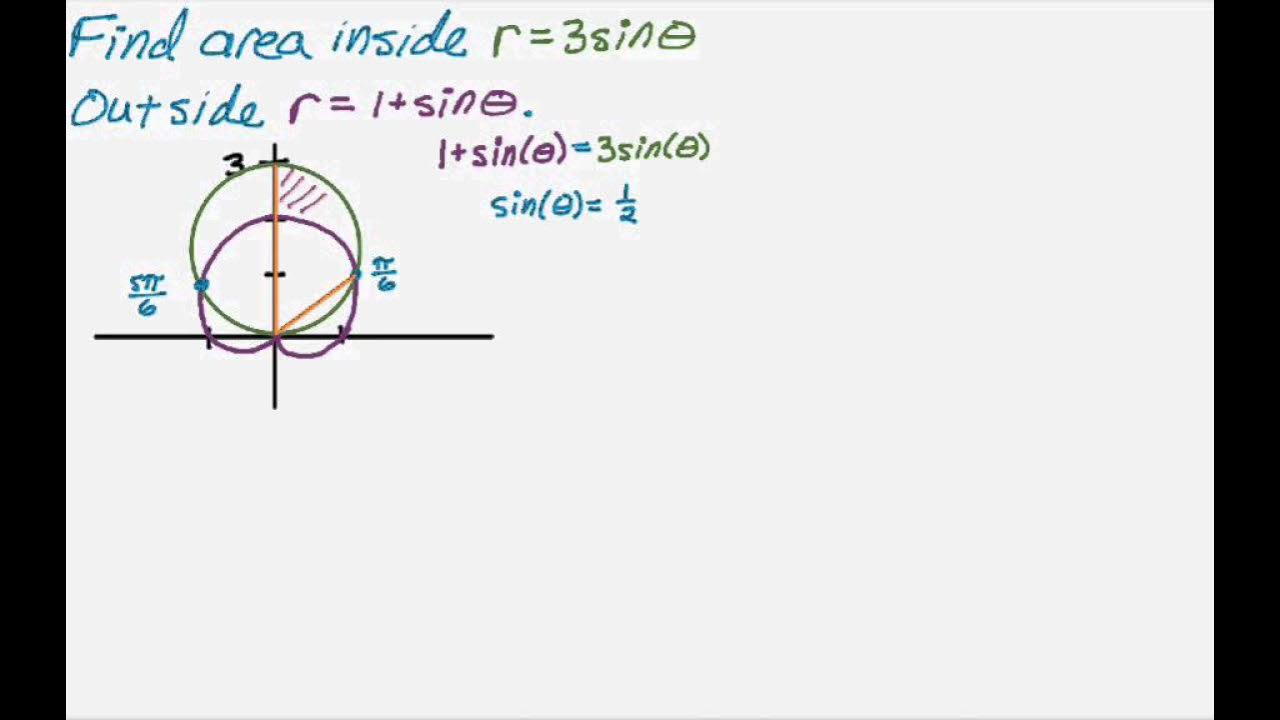Calculus Polar Area Rose Curve Example
TLDRThis educational video script demonstrates the process of finding the area of a petal on a rose curve with the equation R = cos(3θ) using calculus. It emphasizes the importance of graphing the polar curve to understand its pattern and symmetry. The script guides through calculating half the petal's area by integrating from θ = 0 to π/6, simplifying the expression using trigonometric identities, and doubling the result due to symmetry. It also touches on finding the entire area for three petals and offers a helpful alternative approach for the calculation, making it an insightful resource for those learning polar coordinates and calculus.
Takeaways
- 📚 The video discusses finding the polar area of a rose curve, specifically for the equation \( R = \cos(3\theta) \).
- 📈 The first step is to graph the rose curve, which involves finding where \( R = 0 \) and sketching those lines.
- 🔍 The graph is analyzed in the rectangular coordinate system to understand the pattern and trace the polar curve.
- 🌹 The area of interest is one petal of the rose curve, which is half of a petal due to symmetry.
- 🔢 The formula for polar area involves integrating \( \frac{1}{2}R^2 \) with respect to \( \theta \).
- 📉 The integration starts at \( \theta = 0 \) and stops at \( \theta = \frac{\pi}{6} \), where \( R \) first reaches zero.
- 🧮 The integral involves squaring the radius function \( \cos(3\theta) \) and integrating with respect to \( \theta \).
- 📊 The area calculation can be simplified by using trigonometric identities, such as the double angle formula for cosine squared.
- 🔄 An alternative approach is to integrate from \( -\frac{\pi}{6} \) to \( \frac{\pi}{6} \) to cover the entire petal, leveraging the symmetry of the curve.
- 🌐 To find the area of the entire region enclosed by the rose curve, multiply the area of one petal by three, as there are three petals in total.
Q & A
What is the main topic of the video script?
-The main topic of the video script is finding the polar area of one petal of a rose curve defined by the equation R = cos(3θ) using calculus.
What is the first step suggested in the script to approach the problem?
-The first step suggested is to graph the rose curve in polar coordinates, specifically finding where R equals 0 and sketching those lines.
How does the script suggest using symmetry to simplify the calculation of the polar area?
-The script suggests finding half of the petal's area and then using symmetry to double the result, as the formula for polar area already includes a factor of 1/2.
What is the range of θ for the integral when calculating the area of half a petal of the rose curve?
-The range of θ for the integral is from 0 to π/6, as this is the interval where the rose curve completes half a petal before the radius R becomes zero again.
What is the integral expression used to calculate the area of half a petal of the rose curve?
-The integral expression is ∫ from 0 to π/6 of (cos(3θ))^2 dθ.
Why does the script mention using a calculator for the integral calculation?
-The script mentions using a calculator to simplify the process and avoid manual computation, which can be complex and prone to errors.
What is the result of the integral calculation for the area of half a petal as mentioned in the script?
-The result of the integral calculation for the area of half a petal is π/12.
How does the script suggest simplifying the integral using trigonometric identities?
-The script suggests using the double angle formula or power reducing formula to simplify (cos(3θ))^2 to 1 + cos(6θ).
What alternative method is presented in the script for calculating the area of a petal?
-The alternative method presented is to integrate from -π/6 to π/6, which covers both the bottom and top halves of the petal, and then calculate the area.
If the entire area enclosed by the rose curve is desired, how does the script suggest finding it?
-The script suggests multiplying the area of one petal by three, since there are three petals in the rose curve defined by R = cos(3θ).
Outlines
📚 Calculus in Finding Polar Area of a Rose Curve
The script introduces a calculus example to find the area of one petal of a rose curve defined by the polar equation R = cos(3θ). The process begins with graphing the curve and identifying where R equals zero to sketch the petal's boundary. The focus is on finding the area of half a petal due to symmetry, which simplifies the calculation. The area calculation involves setting up an integral from θ = 0 to θ = π/6, squaring the radius function, and integrating with respect to θ. The script mentions using a calculator for the actual computation and provides a hint about simplifying the integral using trigonometric identities, such as the double angle formula for cosine squared.
Mindmap
Keywords
💡Polar Area
💡Rose Curve
💡Graphing
💡Symmetry
💡Polar Coordinates
💡Integral
💡Cosine of 3 Theta
💡Double Angle Formula
💡Pi Over Six
💡Three Petals
Highlights
Introduction to finding polar area using calculus for a rose curve.
Problem statement: Find the area of one petal of R = cos(3θ).
Explanation of graphing a rose curve in polar coordinates.
Identifying where R equals zero to sketch the graph.
Using symmetry to simplify the area calculation.
Deciding to calculate half of the petal area and then doubling it.
Starting the integral at θ = 0 and stopping at θ = π/6.
Expression for the integral: 1/2 ∫(R^2) dθ.
Substituting R = cos(3θ) into the integral.
Using a calculator to compute the integral.
Result of the calculation: Area = π/12.
Mention of using trigonometric identities to simplify the integral.
Alternative method by starting the integral at -π/6.
Explanation of how the integral from -π/6 to π/6 covers one petal.
Multiplying the area of one petal by three to find the total area of the rose curve.
Summary of the process for dealing with rose curves in polar coordinates.
Encouragement and well wishes for the audience.
Transcripts
5.0 / 5 (0 votes)
Thanks for rating:





